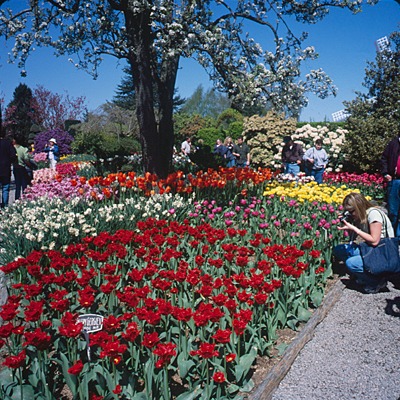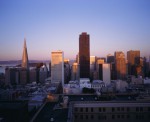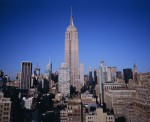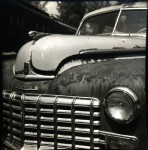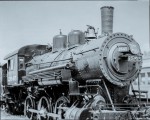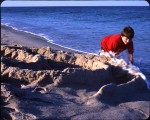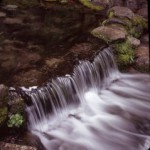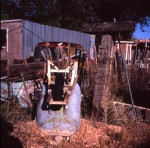Category Archives: FolioB
Submission 2014
Thanks for allowing me to share my images. I’ve enjoyed your beautiful work
- San Francisco 2013 Fuji gf670w Ektachrome e 100g 20 foot separation
- NYC 2013 Fuji gf670w Ektachrome e 100g 30 foot separation
- National Railroad Museum Rusted old Dodge. EFKE 25 processed by DR5 TL120
- National Railroad Museum Steam Engine EFKE 25 processed by DR5 TL120
I was inspired by David Lee’s great hyperstereos to try shooting some of my own. My first attempt was from the Mark hotel in San Francisco, My second from a rooftop bar in NYC.
The others are EFKE 25 DR5 transparencies shot at the National Railroad Museum in Wisconsin. We just had a 3rd boy and moved to Long Island. I also started a new job, so we’ve been busy. I wouldve liked to attend the NSA this year, but maybe some time soon. If any of you are in NYC drop me a line, perhaps we can meet for some mf3d or other photography
Thank you,
Nik Sekhar
Shadows On the Teche
 Located in New Iberia’s Main Street District, set among towering live oak trees draped with Spanish moss on the banks of Bayou Teche, The Shadows, built in 1834 for sugar planter David Weeks, paints a vivid picture of life for the four generations that made this property their home. The Shadows is a Classic Revival-style home with a Louisiana Colonial floor plan and a garden that is as breathtaking as the history preserved here. Continue reading
Located in New Iberia’s Main Street District, set among towering live oak trees draped with Spanish moss on the banks of Bayou Teche, The Shadows, built in 1834 for sugar planter David Weeks, paints a vivid picture of life for the four generations that made this property their home. The Shadows is a Classic Revival-style home with a Louisiana Colonial floor plan and a garden that is as breathtaking as the history preserved here. Continue reading
Grrrrrrrrrr!
 Former car parts and spoons take the shapes of mysterious creatures including prehistoric reptiles, bugs, and even aliens at Scrap Daddy’s Art Yard. Art forms are scattered throughout this museum of sorts, among overgrown grass and metal scraps. Welder and gallery owner, Mark Bradford has an eclectic eye for art that has moved him to put his own distinctive mark on the many metal sculptures displayed in the outdoor gallery. Sights for innovative eyes include the 20-foot praying mantis (that I can’t get out of my mind), a flying saucer, and an automobile-sized scorpion. Bradford welcomes free visits to his yard daily.
Former car parts and spoons take the shapes of mysterious creatures including prehistoric reptiles, bugs, and even aliens at Scrap Daddy’s Art Yard. Art forms are scattered throughout this museum of sorts, among overgrown grass and metal scraps. Welder and gallery owner, Mark Bradford has an eclectic eye for art that has moved him to put his own distinctive mark on the many metal sculptures displayed in the outdoor gallery. Sights for innovative eyes include the 20-foot praying mantis (that I can’t get out of my mind), a flying saucer, and an automobile-sized scorpion. Bradford welcomes free visits to his yard daily.
Michele de George
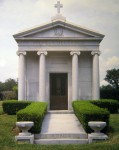 Image taken with the TL 120 in a local cemetery. The Glenwood Cemetery is located at 2525 Washington Avenue in Houston, Texas. It was the first cemetery in Houston to be professionally designed and opened in 1871. The cemetery is situated between Washington Avenue on the North side and Memorial Drive on the South side, the latter overlooking Buffalo Bayou. Designed in the tradition of other romantic rural cemetery parks of the 19th century, Glenwood’s beautiful landscape and towering trees provide the visitor a place of quiet respite just one mile west of downtown Houston.
Image taken with the TL 120 in a local cemetery. The Glenwood Cemetery is located at 2525 Washington Avenue in Houston, Texas. It was the first cemetery in Houston to be professionally designed and opened in 1871. The cemetery is situated between Washington Avenue on the North side and Memorial Drive on the South side, the latter overlooking Buffalo Bayou. Designed in the tradition of other romantic rural cemetery parks of the 19th century, Glenwood’s beautiful landscape and towering trees provide the visitor a place of quiet respite just one mile west of downtown Houston.
Bethel Baptist Church
 The new Bethel Baptist Church Park was developed while memorializing the history and significance of this land to the Fourth Ward. Fourth Ward was the site of the original Freedmen’s Town neighborhood established by freed slaves after the Civil War. Bethel Missionary Baptist, founded in the late 1800’s by the Rev. Jack Yates, has had three sanctuaries on the same site, the earliest built in the 1890’s. The most recent church building, built in 1923, was gutted by fire in 2005, but the walls are still standing. The city bought the property in 2009 to preserve the church facade and to provide park space. The Bethel Park Project restored three walls and converted the rest of the property into a park. It is a really cool place to sit and meditate.
The new Bethel Baptist Church Park was developed while memorializing the history and significance of this land to the Fourth Ward. Fourth Ward was the site of the original Freedmen’s Town neighborhood established by freed slaves after the Civil War. Bethel Missionary Baptist, founded in the late 1800’s by the Rev. Jack Yates, has had three sanctuaries on the same site, the earliest built in the 1890’s. The most recent church building, built in 1923, was gutted by fire in 2005, but the walls are still standing. The city bought the property in 2009 to preserve the church facade and to provide park space. The Bethel Park Project restored three walls and converted the rest of the property into a park. It is a really cool place to sit and meditate.
Looking Through the Ice
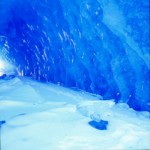 This is a different kind of ice shot. This is a glacier segment which has calved, floated out into the lake, and been trapped in the lake ice when winter arrived. We skated out to the trapped bergs, before shedding our skates to investigate. It was at least 15′ from the surface of the lake to the tunnel roof.
This is a different kind of ice shot. This is a glacier segment which has calved, floated out into the lake, and been trapped in the lake ice when winter arrived. We skated out to the trapped bergs, before shedding our skates to investigate. It was at least 15′ from the surface of the lake to the tunnel roof.
Based on the size of the tunnel, and the shape of the scallops on the walls, I suspect this began as a vertical shaft (moulin) draining water from the surface of the glacier to the interior. The wind and sun continue to work on the ice even in the winter.
Tripod mounted TL120-55
Two Modes of Travel
 Juneau is a government and a tourist town. In the summer, it is all tourists. You arrive by boat, or by plane, and both are common day trips for tourists. The Otters in the background will be loaded with folks heading south of town to the Taku River. They are 50(ish) year old De Havilland aircraft which have been repowered with turbo-props. The steamboat is a fiberglass hulled vessel built in the style of a 1900-vintage launch, but is powered by a 2000-vintage boiler and engine. They run hour-long harbor tours most days of the week.
Juneau is a government and a tourist town. In the summer, it is all tourists. You arrive by boat, or by plane, and both are common day trips for tourists. The Otters in the background will be loaded with folks heading south of town to the Taku River. They are 50(ish) year old De Havilland aircraft which have been repowered with turbo-props. The steamboat is a fiberglass hulled vessel built in the style of a 1900-vintage launch, but is powered by a 2000-vintage boiler and engine. They run hour-long harbor tours most days of the week.
Tripod-mounted TL120-1, taken on one of my noon-time walks.
Overflow!
Windows on the World
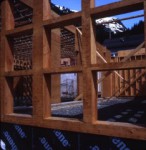 Several years ago (2006), a disgruntled man set fire to a homeowner’s boat (on a trailer behind their house). The fire spread to their house and the adjacent church and burned both to the ground. If the winds had been different, a large section of Juneau could easily have disappeared that night. Three years, and many contributions later, enough of the church had been rebuilt to begin services again.
Several years ago (2006), a disgruntled man set fire to a homeowner’s boat (on a trailer behind their house). The fire spread to their house and the adjacent church and burned both to the ground. If the winds had been different, a large section of Juneau could easily have disappeared that night. Three years, and many contributions later, enough of the church had been rebuilt to begin services again.
This was shot from the sidewalk during reconstruction, probably hand-held, during a noon-time walk.
Yosemite Fall
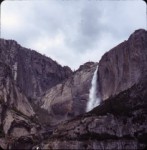 Yosemite Fall is one of the most popular and well-recognized sights in Yosemite Valley. The image was made from near the Sentinel Bridge. The cameras were 2 Bronica SQAs with 80 mm lenses (normal focal length). I had them on tripods about 15 yards apart. The shutters were synchronized by my tossing a rock in the air and when it hit the ground I and a friend at the other camera released the shutters at the same instant.
Yosemite Fall is one of the most popular and well-recognized sights in Yosemite Valley. The image was made from near the Sentinel Bridge. The cameras were 2 Bronica SQAs with 80 mm lenses (normal focal length). I had them on tripods about 15 yards apart. The shutters were synchronized by my tossing a rock in the air and when it hit the ground I and a friend at the other camera released the shutters at the same instant.
Water-Eroded Granite
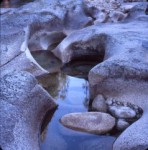 The location of this image was along Illilouette Creek which is southeast of Yosemite Valley. I was on a several day backpacking trip in the summer of 2009 at the time. There is granite everywhere in Yosemite. Wherever water is running it carves and polishes the granite over hundreds of thousands of years. This image was made with the TL-120 stereo camera.
The location of this image was along Illilouette Creek which is southeast of Yosemite Valley. I was on a several day backpacking trip in the summer of 2009 at the time. There is granite everywhere in Yosemite. Wherever water is running it carves and polishes the granite over hundreds of thousands of years. This image was made with the TL-120 stereo camera.
Fern Spring (Detail)
Base of Cascade Fall
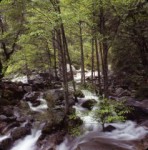 This image was made in 2008. Cascade Fall is just outside of Yosemite Valley. You can see it from Highway 140 as you are driving in to the valley. To make the image I used 2 Bronica SQA cameras with 50mm lenses (wide angle). The cameras were 4 inches apart on a tripod. I can’t remember the exact exposure time, but it was around 10 seconds.
This image was made in 2008. Cascade Fall is just outside of Yosemite Valley. You can see it from Highway 140 as you are driving in to the valley. To make the image I used 2 Bronica SQA cameras with 50mm lenses (wide angle). The cameras were 4 inches apart on a tripod. I can’t remember the exact exposure time, but it was around 10 seconds.
